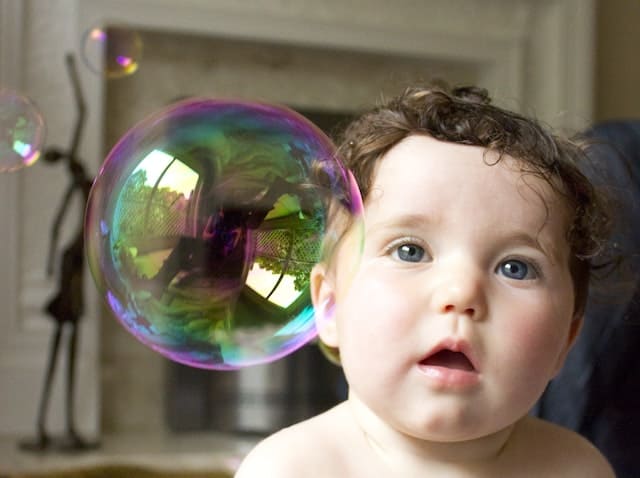Accidentally poking a baby in the eye can be a scary experience for any parent or caregiver. Even though it’s a common accident, it can cause significant discomfort and pain to the baby.
Eye injuries in babies can range from mild to severe, and it’s essential to understand the potential risks and take appropriate measures to prevent them.
Most accidental eye pokes happen when a baby is exploring their surroundings. Babies have a natural curiosity to touch and grab objects, and sometimes they can accidentally poke themselves in the eye.
It’s crucial to be aware of the common causes of accidental eye pokes to prevent them from happening in the first place. In this article, we’ll discuss the symptoms of eye injuries, first aid measures, and when to seek medical attention.
Key Takeaways
- Accidentally poking a baby in the eye is a common accident that can cause discomfort and pain.
- Understanding the common causes of accidental eye pokes and taking appropriate measures to prevent them is crucial.
- It’s essential to know the symptoms of eye injuries, provide first aid measures, and seek medical attention when necessary.
Understanding Eye Injuries in Babies
Eye injuries in babies can be a cause of concern for parents and caregivers. Babies are curious and tend to explore their surroundings using their hands and mouth. This can lead to accidental poking, scratching, or rubbing of their eyes, which can result in eye injuries.
Eye injuries in babies can range from minor scratches to more serious injuries such as corneal abrasions, eyelid cuts, and blunt trauma. Common causes of eye injuries in babies include falling, poking, and foreign objects such as dust, nails, or boards.
Symptoms of eye injuries in babies may include redness, swelling, bruising, and tearing. Babies may also blink excessively or avoid blinking altogether, or they may rub their eyes frequently.
In more serious cases, babies may experience vision changes or loss of vision.
If a baby has an eye injury, it is important to seek medical attention immediately. Delaying treatment can lead to further complications and permanent damage to the eye.
Treatment for eye injuries in babies may include cleaning the eye, applying eye drops or ointments, or even surgery in more severe cases.
In summary, eye injuries in babies can be caused by a variety of factors and can range from minor scratches to serious trauma.
Symptoms of eye injuries may include redness, swelling, and tearing, and it is important to seek medical attention immediately if an injury occurs. With prompt and appropriate treatment, most eye injuries in babies can be treated successfully.
Here are some ways you can help prevent your child from poking his eyes:
Common Causes of Accidental Eye Pokes
Accidental eye pokes are a common occurrence, especially among children. It can happen due to various reasons, including rubbing of the eyes, sharp objects, and falls. In this section, we will discuss some of the most common causes of accidental eye pokes.
Kids
Children are more susceptible to accidental eye pokes due to their playful nature. They tend to touch and poke things without realizing the consequences.
Kids also tend to rub their eyes when they are tired or have an itch, which can lead to accidental eye pokes.
Sports
Sports-related eye injuries are also a common cause of accidental eye pokes. Contact sports like basketball, football, and hockey can cause eye injuries due to rough play or accidental contact with an opponent’s hand or elbow.
Rubbing
Rubbing the eyes is a common cause of accidental eye pokes. When you rub your eyes, you increase the pressure inside the eye, which can cause the eye to bulge out slightly.
If you accidentally poke your eye while rubbing, it can cause serious damage.
Poke in the Eye
A poke in the eye is the most obvious cause of an accidental eye poke. It can happen due to various reasons, including accidental contact with a sharp object or a finger.
A poke in the eye can cause serious damage to the eye and should be treated immediately.
Sharp Objects
Sharp objects like pencils, scissors, and knives can also cause accidental eye pokes. It is important to keep sharp objects away from children and to use them carefully to avoid accidental eye pokes.
Falling
Falling is another common cause of accidental eye pokes. When you fall, you may accidentally hit your eye on a hard surface or object, which can cause serious damage. It is important to be careful when walking or running to avoid accidental falls.
In summary, accidental eye pokes can happen due to various reasons, including rubbing, sports, sharp objects, and falls. It is important to be careful and take precautions to avoid accidental eye pokes.
Symptoms of Eye Injury
Eye injuries in babies can be serious and require immediate medical attention. It is important to recognize the symptoms of an eye injury so that prompt treatment can be provided.
Symptoms of an eye injury can vary depending on the severity of the injury and can include:
- Redness of the eye
- Tearing
- Eye pain
- Swollen eyelids
- Blurred vision
If a baby has been accidentally poked in the eye, it may result in a scratch on the surface of the eye. This can cause redness and tearing of the eye.
The baby may also experience eye pain and sensitivity to light. In some cases, the eye may become swollen and the baby may have difficulty opening or closing their eye.
If the eye injury is more severe, it may result in blurred vision or a change in the shape of the eye. The baby may also experience a sudden increase in eye pressure, which can cause redness and pain in the eye.
If you suspect that your baby has an eye injury, it is important to seek medical attention immediately. Delaying treatment can result in permanent damage to the eye and loss of vision.
First Aid for Accidental Eye Pokes
Accidental eye pokes can happen to anyone, especially babies who are still exploring their surroundings. It is important to act quickly and calmly to prevent further damage to the eye.
Here are some first aid steps to take:
- Clean water: The first step is to flush the eye gently with clean water. Use a cup or a clean cloth soaked in water to rinse the eye. This will help to remove any dirt or debris that may have entered the eye.
- Minimal contact: Avoid touching the eye or rubbing it, as this can cause further damage. Encourage the baby to keep their eyes closed to prevent any further irritation.
- Cool compress: Apply a cool compress to the affected eye to help reduce swelling and ease any discomfort. You can use a clean cloth soaked in cool water or a cold pack wrapped in a towel.
- Bandage: If the eye is bleeding or there is a cut, cover it with a sterile bandage to prevent any infection. Be sure to apply the bandage gently and avoid putting pressure on the eye.
Remember, if the eye is severely injured, seek medical attention immediately. These first aid steps are only meant to provide temporary relief until professional help is available.
When to Seek Medical Attention
If a baby has been accidentally poked in the eye, it is important to know when to seek medical attention. While most minor injuries will heal on their own, some may require medical treatment to prevent further damage or discomfort.
If the baby is experiencing any of the following symptoms, it is recommended to seek medical attention from a doctor or ophthalmologist:
- Vision changes
- Discomfort or pain in the eye
- Bleeding from the eye
- Cornea damage
If the baby is exhibiting any of these symptoms, it is important to see an eye doctor as soon as possible. Delaying medical attention could result in long-term vision problems or even permanent damage to the eye.
It is also important to note that even if the baby is not experiencing any symptoms, it may still be necessary to seek medical attention. Some injuries may not be immediately apparent and could worsen over time.
In summary, if a baby has been accidentally poked in the eye, it is important to closely monitor their symptoms and seek medical attention if necessary. A doctor or ophthalmologist can provide the necessary treatment to prevent further damage and ensure the baby’s vision is not affected.
Treatment and Medication
If a baby has been accidentally poked in the eye, the first step is to examine the eye for any signs of injury. If there is a visible scratch on the cornea or a scratched cornea, it is important to seek medical attention immediately.
In many cases, the injury may cause discomfort or pain to the baby. Over-the-counter pain relievers such as Advil or Tylenol may be used to alleviate the pain.
However, it is important to consult a doctor before giving any medication to a baby.
In some cases, the doctor may prescribe eye drops or artificial tears to help soothe the eye and promote healing. These may also help to reduce any inflammation or swelling in the eye.
It is important to keep the eye clean and dry to prevent any further irritation or infection. The doctor may recommend using a sterile saline solution or warm compresses to clean the eye.
If the injury is severe, the doctor may recommend more advanced treatment options, such as surgery or a patch over the eye.
However, these options are typically reserved for more serious injuries or cases where the injury does not heal on its own.
Overall, it is important to seek medical attention if a baby has been accidentally poked in the eye. With proper treatment and care, most injuries will heal on their own within a few days to a week.
Preventing Future Eye Injuries
Accidents happen, but there are steps parents and caregivers can take to prevent future eye injuries in babies.
Here are some tips to help protect your little one’s eyes:
Eye Protection
One of the most effective ways to prevent eye injuries is to use eye protection. For example, if your baby is playing with toys that have small parts or sharp edges, make sure they wear protective eyewear.
Additionally, if you’re doing any DIY projects or using power tools, wear protective eyewear yourself, and keep your baby out of the area.
Safe Search
Babies love to explore, but it’s important to make sure they’re doing so in a safe environment. Keep small objects, such as coins and buttons, out of reach, and make sure any toys they’re playing with are age-appropriate. Regularly inspect toys for any sharp edges or broken parts.
Safe Sleeping
When it comes to sleep time, make sure your baby’s crib is a safe space. Avoid using any toys or objects that could potentially harm their eyes, such as mobiles with sharp pieces or strings that could wrap around their neck.
By taking these precautions, you can help protect your baby’s eyes and prevent future injuries.
Understanding Eye Conditions Resulting from Accidental Pokes
Accidentally poking a baby in the eye can lead to various eye conditions, including a red spot, foreign object, eye infection, subconjunctival hemorrhage, broken blood vessel, and blurred vision.
A red spot on the white part of the eye is a common symptom of a subconjunctival hemorrhage. This occurs when a blood vessel in the eye ruptures, causing blood to leak into the conjunctiva, the clear membrane that covers the white part of the eye.
The red spot may look alarming, but it is usually painless and does not affect vision. The redness usually disappears within a week or two.
When a foreign object enters the eye, it can cause irritation, redness, and discomfort. The object may be visible on the surface of the eye or may require medical attention to remove.
It is important to seek medical attention promptly if a foreign object is suspected to prevent further damage to the eye.
An eye infection can also result from an accidental poke. Symptoms may include redness, swelling, discharge, and blurred vision. Treatment may include antibiotics and other medications to reduce inflammation and relieve symptoms.
A broken blood vessel in the eye can cause redness and pain. This may occur when a blood vessel in the eye ruptures due to trauma, such as an accidental poke.
The redness usually disappears within a week or two, and pain can be managed with over-the-counter pain relievers.
Blurred vision can also occur after an accidental poke. This can be due to damage to the cornea or other structures in the eye. It is important to seek medical attention promptly if blurred vision occurs to prevent further damage to the eye.
In conclusion, accidental pokes in the eye can lead to various eye conditions, including a red spot, foreign object, eye infection, subconjunctival hemorrhage, broken blood vessel, and blurred vision.
It is important to seek medical attention promptly if any of these symptoms occur to prevent further damage to the eye.
Potential Long-Term Effects
Accidentally poking a baby in the eye can cause potential long-term effects that may affect the child’s vision and overall eye health.
The cornea, which is the clear outer layer of the eye, can be damaged by a poke, resulting in discomfort and an increased risk of infections.
If the injury is severe, it can cause permanent damage to the cornea and affect the child’s vision. Harmful chemicals or foreign objects that enter the eye can also cause long-term damage and may require immediate attention from an optometrist.
In addition to physical damage, an eye injury can also cause emotional trauma to the child and parents. It is important to seek medical attention as soon as possible to prevent further damage and to ensure proper treatment.
To prevent accidental eye injuries, parents should always supervise their children during playtime and keep harmful objects out of reach. It is also important to teach children about eye safety and the importance of protecting their eyes.
Overall, while accidental eye injuries can have potential long-term effects, seeking prompt medical attention and taking preventative measures can help minimize the risk of harm and ensure the child’s eye health.
Related: Is It Normal for Babies’ Eyes to Roll Back in Their Head
Frequently Asked Questions
When should I take my baby to a doctor after accidentally poking their eye?
If your baby’s eye is red, swollen, or has a discharge, you should take them to a doctor as soon as possible. If your baby is experiencing pain, sensitivity to light, or has trouble opening their eye, you should also seek medical attention.
How can I tell if my baby’s eye is scratched after being accidentally poked?
If your baby is blinking excessively, rubbing their eye, or has redness or tearing, they may have a scratched eye. You should take your baby to a doctor to determine the extent of the injury.
What are the signs of a serious eye injury in a baby?
If your baby’s eye is bleeding, has a visible cut, or is bulging out of its socket, it may be a sign of a serious eye injury. Other signs include loss of vision, swelling, or discoloration around the eye. It is important to seek medical attention immediately if you suspect a serious eye injury.
What is the best way to flush a baby’s eye if something gets in it?
If something gets in your baby’s eye, the best way to flush it out is to use saline solution or clean water. Tilt your baby’s head to the side and pour the solution into the affected eye. You can also use a clean cloth or cotton ball to wipe away any debris.
Can a baby’s eye injury from accidental poking lead to long-term vision problems?
In most cases, a minor eye injury from accidental poking will not lead to long-term vision problems. However, if the injury is severe or left untreated, it can result in permanent vision loss.
Is it necessary to take a baby to the ER for a minor poke in the eye?
If the poke is minor and there are no signs of serious injury, it may not be necessary to take your baby to the emergency room.
However, if you are unsure or concerned about your baby’s eye injury, it is always best to seek medical attention to ensure their safety and well-being.
Learn more from another post: How To Tell If Your Baby Is Blind

Iesha is a loving mother of 2 beautiful children. She’s an active parent who enjoys indoor and outdoor adventures with her family. Her mission is to share practical and realistic parenting advice to help the parenting community becoming stronger.



